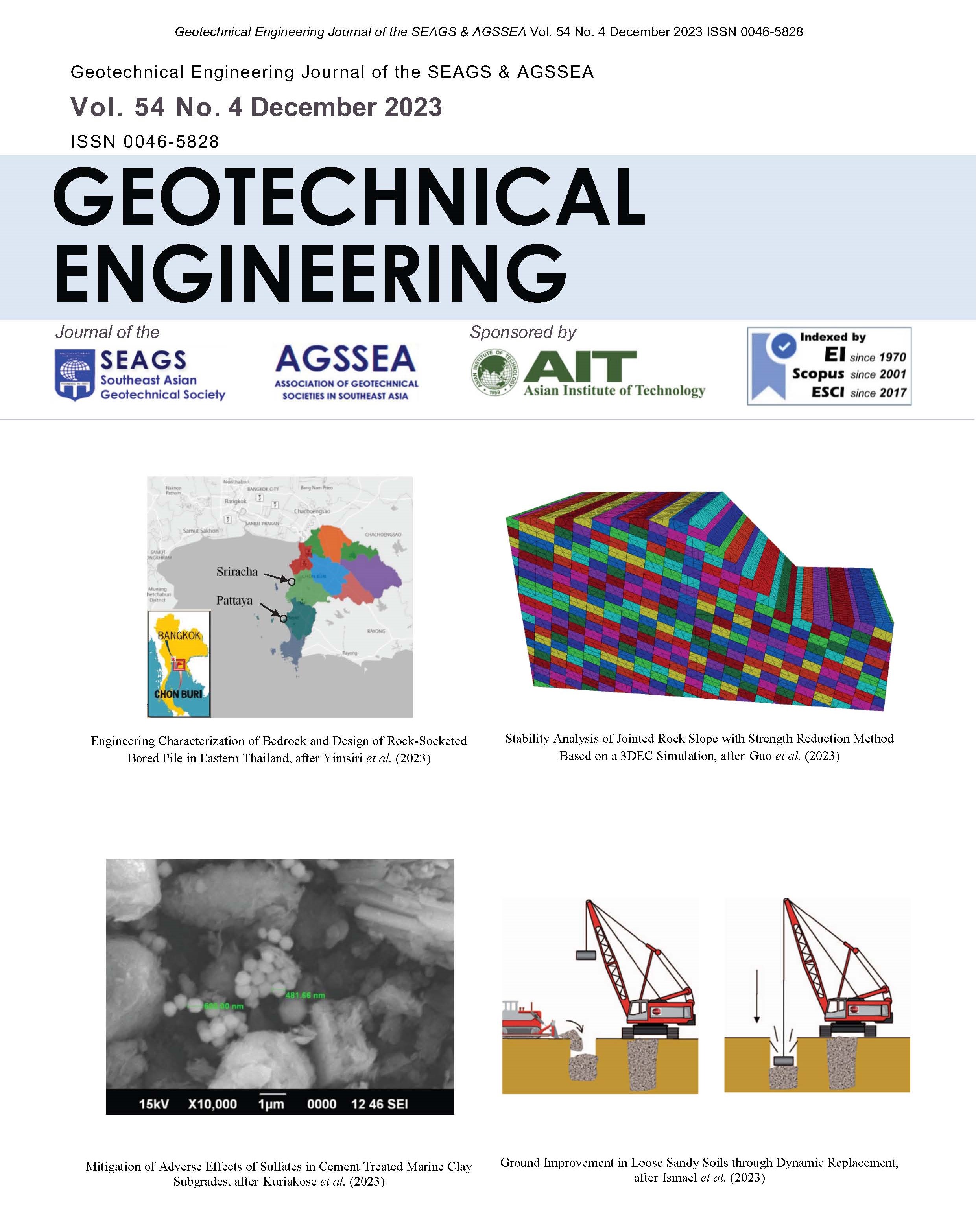Neutralization of Phosphogypsum for Use in Base Lining System of Phosphogypsum Dumping Yards
Main Article Content
Abstract
Phosphogypsum is generated as a by-product during the manufacturing of phosphoric acid by wet process. Annually, the worldwide projected value of phosphogypsum generation is 100-280 metric tons. Due to its acidic nature, radioactivity, high fluorine content, presence of trace elements and huge volume, direct dumping of phosphogypsum on the ground results in subsoil and groundwater contamination. Hence, it is essential to dump phosphogypsum properly in engineered landfills. To overcome these issues in India, the Central Pollution Control Board (CPCB) has suggested a composite liner system for the safe disposal of phosphogypsum on the ground. The lower part of the suggested liner system comprises of placement of HDPE geomembrane over a layer of compacted clay or compacted amended soil layer or a mixture of native soil with bentonite and in the lower part of the composite liner system, a layer of mechanically compacted and neutralized phosphogypsum is placed above the drainage layer. Hence, the present work is intended to neutralize phosphogypsum with lime, fly ash, and pond ash and to assess the suitability of neutralized phosphogypsum for use in the upper part of the composite liner system of phosphogypsum ponds. The study indicated effective neutralization of phosphogypsum with 1.6% lime and 50% fly ash.
Article Details

This work is licensed under a Creative Commons Attribution-NonCommercial-NoDerivatives 4.0 International License.
Copyright © 2019 Association of Geotechnical Societies in Southeast Asia (AGSSEA) - Southeast Asian Geotechnical Society (SEAGS).
References
Arocena JM, Rutherford PM and Dudas MJ (1995) Heterogeneous distribution of trace elements and fluorine in phosphogypsum by-product. Science of the Total Environment 162(2–3): 149–160.
CPCB (Central Pollution Control Board) (2014) Guidelines for Management, Handling, Utilisation and Disposal of Phosphogypsum Generated from Phosphoric Acid Plants. Ministry of Environment & forests, Delhi, India.
Dutta RK and Kumar V (2016) Suitability of fly ash-lime-phosphogypsum composite in road pavements. Periodica Polytechnica - Civil Engineering 60(3): 455–469.
Dvorkin L, Lushnikova N and Sonebi M (2018) Application areas of phosphogypsum in production of mineral binders and composites based on them: A review of research results. MATEC Web of Conferences 149: 1–9.
Gennari RF, Medina NH, Garcia I and Silveira MAG (2011) Phosphogypsum analysis: total content and extractable element concentrations. International Nuclear Atlantic Conference - INAC 2011 10(1).
Islam GMS, Chowdhury FH, Raihan MT, Amit SKS, and Islam MR
(2017) Effect of Phosphogypsum on the Properties of Portland Cement. Procedia Engineering 171: 744–751.
Liu S, Fang P, Ren J and Li S (2020) Application of lime neutralized phosphogypsum in supersulfated cement. Journal of Cleaner Production 272.
Men J, Li Y, Cheng P and Zhang Z (2022) Recycling phosphogypsum in road construction materials and associated environmental considerations A review. Heliyon, 8(11).
Meskini S, Samdi A, Ejjaouani H and Remmal T (2021) Valorization of phosphogypsum as a road material Stabilizing effect of fly ash and lime additives on strength and durability. Journal of Cleaner Production 323.
Neto JSA, Bersch JD, Silva TSM, Rodriguez ED, Suzuki S and Kirchheim AP (2021) Influence of phosphogypsum purification with lime on the properties of cementitious matrices with and without plasticize. Construction and Building Materials 299.
Palla S, Sharma P, Rao MVR, Ramakrishna S, Vanguri S and Mohapatra BN (2022) Solar thermal treatment of phosphogypsum and its impact on the mineralogical modification for effective utilization in cement production. Journal of Building Engineering 51.
Rutherford PM, Dudas MJ and Arocena JM (1995) Trace elements and fluoride in phosphogypsum leachates. Environmental Technology (United Kingdom) 16(4):343–354.
Saadaoui E, Ghazel N, Romdhane CB and Massoudi N (2017) Phosphogypsum: potential uses and problems–a review. International Journal of Environmental Studies 74(4): 558–567.
Shen W, Zhou M and Zhao Q (2007) Study on lime-fly ash-phosphogypsum binder. Construction and Building Materials 21(7): 1480–1485.
Tayibi H, Choura M, Lopez FA, Alguacil FJ and Delgado AL (2009) Environmental impact and management of phosphogypsum. Journal of Environmental Management 90(8): 2377–2386.
Tulasi K and Satyanarayana Reddy CNV (2022) Phosphogypsum dumping yards - a review. In proceedings of the 7th Indian Young Geotechnical Engineers Conference, Lecture Notes in Civil Engineering (A. K. Dey et al. (eds.)). Lecture Notes in Civil Engineering, Springer, Singapore, Vol. 195, pp. 405 – 411.
IS 2720-13 (1986): Methods of test for soils, Part 13. Direct shear test. Bureau of Indian Standards, New Delhi, India.
IS:2720 - 16 (1987): Method of test for soils, Part 16. Laboratory determination of CBR. Bureau of Indian Standards, New Delhi, India.
IS 2720 -17 (1986): Method of test for soils, Part 17. Laboratory determination of permeability. Bureau of Indian Standards, New Delhi, India.
IS 2720 - 8 (1983): Method of test for soils, Part 8. Determination of water content-dry density relation using heavy compaction. Bureau of Indian Standards, New Delhi, India.


